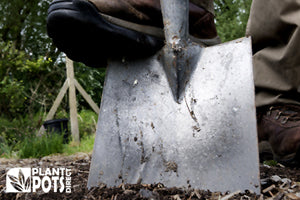
Allotment Gardener - February job list
 We are now well into the 2nd week of February, the days are getting longer and the hunger to get back to the plot is growing by the day. I've put together a few jobs that you can be doing to feed your hunger and at the same time prepare yourself for the busy months ahead.
We are now well into the 2nd week of February, the days are getting longer and the hunger to get back to the plot is growing by the day. I've put together a few jobs that you can be doing to feed your hunger and at the same time prepare yourself for the busy months ahead.
The key to February is the weather, some years it can be mild and give the allotment a huge boost and then other years it can be the coldest month of the year, even colder than December and January. The other factor to February is the rain, if we have a wet month the ground can get too wet for planting anything at all, if we attempt to sow something the wet conditions could ruin the germination. My advice would be to take the risk, if we get lucky we can be a few weeks ahead and to see something growing on the plot is a good motivator to continue in the cold winter mornings.
1. Harvest
After my first visit to my allotment there wasn't a great deal of plants left from the Autumn harvest so this task is one I can tick off my list without actually doing anything. Some allotment gardeners maybe a little more fortunate and the final harvest from last years crop can take place throughout this month. Cabbages, Sprouts, Cauliflowers, Kale, Leeks, Celeriac, Parsnips and swede are all vegetables which are strong enough take the low temperatures over December and January, but February is the month were they should be making way for this season.
2. Dig over the plot
February is an excellent time to give your beds one final dig before the planting can begin. Turn over the soil to aerate it and remove any weeds (or unwanted plant) that have survived the winter. If the soil is very wet, use a plank of wood across your bed to stand on, it saves you ending up with boots covered in mud.
There is still plenty of time to add your compost or manure to your beds, dig it in while you are turning your soil or leave it on the top for the worms to draw down into the soil.
3. Plant
February is the month to put a few seeds and plants into the ground, but remember this is a gamble depending on the weather conditions and the wetness of the soil.
Items to plant or sow directly into the ground:
- Garlic - Sow the cloves directly into the ground in their final growing area.
- Shallot Sets - Sow the sets directly into the ground in their final growing area.
- Broad Beans - Sow the seeds directly into the ground in their final growing area.
- Jerusalem Artichhokes - Plant tubers directly in to the soil, if the weather is very cold protect with cloches.
- Peas - If the weather is very mild, February is a month you can sow the seeds directly in the soil.
- Fruit trees - The trees are still dormant, February is an excellent month to get the roots in the soil ready for the growing season.
4. Sow
February is the month the sowing inside gets really underway, making used of the greenhouse and window bottoms is key to timing of having plants ready to plant in the coming months.
Seed to sow in a seed trays / cell pack and allow to germinate in the greenhouse or a cooler part of the house: Broad Beans, Peas, Garlic and Shallots Sets.
Seeds to sow in plug trays / seed trays and allow to germinate in a heated propagator or in a warm place under a propagator lid: Turnip, Brussel Sprouts, Leeks, Onion seeds, Lettuce, Radish, Salad Leaves, Spinach, Sprouting Broccoli and Tomatoes.
5. Chitting
Make sure your seed potatoes ready for planting by the end of the month. Spread the seed potatoes out in an egg box or seed tray and leave is a cool / light room to allow for the potatoes to start sprouting shoots. If the potato shoots look pale or spindly, then the room is probably too dark or warm.
6. Tend to the fruit plants on the plot
While the plants are in a dormant state, it a good time to tend to the plants ready for the temperature change during the coming months and the plant goes in to a growing state.
Raspberries - Both summer and Autumn Raspberries need pruning, but in different ways. The summer plants require no more than a trim at the top of the plant, cut off the tops so they are only slightly taller than their supports or bend them over in a hoop, with the top of the cane pointing to the floor. Autumn plants should be cut right down at the ground level, this type of Raspberry will then produce fruit on ne canes in the Autumn.
Strawberries - February is a good month to tidy up the Strawberry bed, identify the plants that you would like to keep and remove the older plants that are now producing less fruit. Remove any dead leaves and detach the runners leaving the plant to support itself over the next few months. Any runners you have removed, pot up in a plant pot and place in the green house to give them a little boost, before adding them to the bed next month.
Gooseberries, Currents and Blueberries - Prune the established bushes by removing any dead or diseased wood, these will only weaken the plants and won't produce much fruit.
All of the fruit plants would benefit from a good feed around the base of the plant. Use a high-potash fertilizer or an organic mixture of fish/blood/bone. If possible add some well rotted down farmyard manure or compost.

Comments
Leave a comment